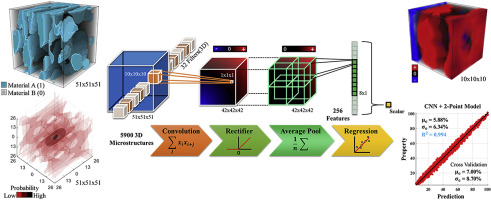当前位置:
X-MOL 学术
›
Acta Mater.
›
论文详情
Our official English website, www.x-mol.net, welcomes your
feedback! (Note: you will need to create a separate account there.)
Material structure-property linkages using three-dimensional convolutional neural networks
Acta Materialia ( IF 8.3 ) Pub Date : 2018-03-01 , DOI: 10.1016/j.actamat.2017.11.053 Ahmet Cecen , Hanjun Dai , Yuksel C. Yabansu , Surya R. Kalidindi , Le Song
Acta Materialia ( IF 8.3 ) Pub Date : 2018-03-01 , DOI: 10.1016/j.actamat.2017.11.053 Ahmet Cecen , Hanjun Dai , Yuksel C. Yabansu , Surya R. Kalidindi , Le Song

|
Abstract The core materials knowledge needed in the accelerated design, development, and deployment of new and improved materials is most accessible when cast in the form of computationally low cost (reduced-order) and reliable process-structure-property (PSP) linkages. Quantification of the material structure (also referred as microstructure) is the core challenge in this task. Conventionally, microstructure quantification has been addressed using highly simplified measures suggested by the governing physics, with the list of measures often suitably augmented by the intuition of the materials expert. In this paper, we develop an objective (data-driven) approach to efficiently and accurately link a three-dimensional (3-D) microstructure to its effective (homogenized) properties. Our method employs a 3-D convolutional neural network (CNN) to learn the salient features of the material microstructures that lead to good predictive performance for the effective property of interest. We then utilize 3-D CNN learned features as estimators of higher-order spatial correlations, and formulate an integrated framework combining 3-D CNN features with 2-point spatial correlations. In this work, we created an extremely large microstructure-property benchmark dataset of 5900 microstructures, and demonstrated that our CNN based approach not only learns interpretable microstructure features, but also leads to improved accuracy in property predictions for new microstructures, while achieving a dramatic reduction in the computation time.
中文翻译:

使用三维卷积神经网络的材料结构-性能联系
摘要 当以计算成本低(降阶)和可靠的工艺-结构-性能 (PSP) 联系形式进行铸造时,最容易获得加速设计、开发和部署新材料和改进材料所需的核心材料知识。材料结构(也称为微观结构)的量化是这项任务的核心挑战。传统上,微观结构量化已经使用由支配物理学提出的高度简化的测量来解决,测量列表通常由材料专家的直觉适当地增加。在本文中,我们开发了一种客观(数据驱动)方法,以有效且准确地将三维(3-D)微观结构与其有效(均质化)特性联系起来。我们的方法采用 3-D 卷积神经网络 (CNN) 来学习材料微结构的显着特征,从而对感兴趣的有效属性产生良好的预测性能。然后,我们利用 3-D CNN 学习到的特征作为高阶空间相关性的估计器,并制定了一个将 3-D CNN 特征与 2 点空间相关性相结合的集成框架。在这项工作中,我们创建了一个包含 5900 个微结构的超大微结构性能基准数据集,并证明我们基于 CNN 的方法不仅可以学习可解释的微结构特征,而且还提高了对新微结构的性能预测的准确性,同时实现了显着减少在计算时间。
更新日期:2018-03-01
中文翻译:

使用三维卷积神经网络的材料结构-性能联系
摘要 当以计算成本低(降阶)和可靠的工艺-结构-性能 (PSP) 联系形式进行铸造时,最容易获得加速设计、开发和部署新材料和改进材料所需的核心材料知识。材料结构(也称为微观结构)的量化是这项任务的核心挑战。传统上,微观结构量化已经使用由支配物理学提出的高度简化的测量来解决,测量列表通常由材料专家的直觉适当地增加。在本文中,我们开发了一种客观(数据驱动)方法,以有效且准确地将三维(3-D)微观结构与其有效(均质化)特性联系起来。我们的方法采用 3-D 卷积神经网络 (CNN) 来学习材料微结构的显着特征,从而对感兴趣的有效属性产生良好的预测性能。然后,我们利用 3-D CNN 学习到的特征作为高阶空间相关性的估计器,并制定了一个将 3-D CNN 特征与 2 点空间相关性相结合的集成框架。在这项工作中,我们创建了一个包含 5900 个微结构的超大微结构性能基准数据集,并证明我们基于 CNN 的方法不仅可以学习可解释的微结构特征,而且还提高了对新微结构的性能预测的准确性,同时实现了显着减少在计算时间。











































 京公网安备 11010802027423号
京公网安备 11010802027423号